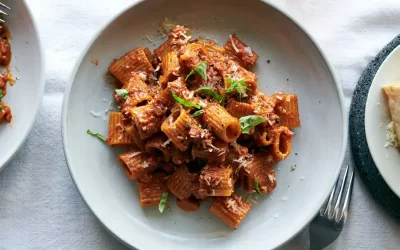Burnt, crispy, and spicy are the three essentials spaghetti all’assassina, or “killer’s spaghetti,” a must-eat in Bari, a city in Puglia on the Adriatic Sea. The name assassina, which means killer, refers not to the felony, but rather the risottatura cooking technique that cooks pasta like risotto. Instead of boiling the spaghetti, it’s cooked directly in the pan by consistently adding water to it each time the pasta absorbs it.
Serves 4
INGREDIENTS
12 oz. vermicelli or spaghetti
2 cups tomato purée
tomato paste
oil
garlic
sugar
chili pepper
INSTRUCTIONS
Prepare a broth made with water, 1½ cups purée, and plenty of tomato paste and salt, and bring to a boil. According to the academy, the sauce “must be bright red and tasty, but still a broth.”
In the iron frying pan, add ½ cup oil, 3 garlic cloves (core removed), and chili pepper to taste. Dell’Erba suggests keeping 2 whole and chopping 1. Cook the garlic over a high flame until golden then pour in around ½ cup tomato purée. To temper the acidity from the tomatoes, you can add 1 tsp. sugar.
Spread the purée over the whole pan with a wooden spoon and let it reduce slightly. At this point put the uncooked spaghetti in the pan, distributing them in such a way that the pasta collects the sauce.
“Now the chef starts to take a step back,” explains Dell’Erba. “You don’t have to be in a hurry to turn everything, you have to wait for some of the spaghetti to start the shining process, not burning, but caramelizing”.
Stir spaghetti as it starts to stick to the bottom of the pan a little, swapping the top layer of noodles for those already glossy from having been stuck to the bottom.
At this point add 2 medium-sized ladles of the tomato “broth.” The liquid will sizzle and start to simmer. Let it reduce without turning the spaghetti and “listen” for the boiling point. When you hear it “sizzle” again (the noise changes sharply), keep your distance and wait for the “burning” process to continue (this will take 30 seconds to 1 one minute).
Repeat, stirring to remove the burnt spaghetti from the bottom of the pan while adding more tomato liquid. Each addition must correspond to the time needed for it to sizzle and then repeat by soaking the pasta with the sauce. The stiff spaghetti will start to bend, and the whole process takes about 8-9 minutes. – the assassina “must suffer.”
The result is a hard spaghetti with a different consistency than boiled spaghetti, but only the burnt ones “crunch.” You need to taste it to decide the level of cooking and burning, and serve it when you think it’s ready – bring the pan directly to the table.




